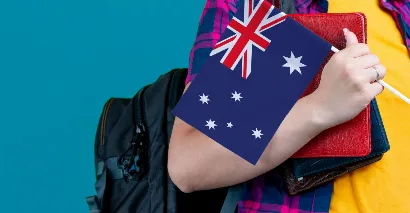Key Highlights
- What Is the MATES Scheme?
- Eligibility Criteria: Who Can Apply?
- Application Process & Ballot System
- Why This Matters for Indian Graduates & Professionals
- Implications for Australia and India
- Tips for Prospective Applicants
- Key Considerations & Challenges
- What It Means for Migration & Talent Ecosystem
- Conclusion
Recently, the Australian government registered registrations under the name of the Mobility Arrangement of Talented Early-Professionals (MATES) scheme for the 2025-26 year, where eligible Indian graduates and professionals can apply. This is a big chance for young Indian talent to experience the international job life and also to be able to help in advancing the emerging industries in Australia, with 3,000 visa places with no employer sponsorship requirement. The ballot is opened when both nations are intensifying their cooperation in migration and mobility, which provides an opening that combines flexibility, skills building and transnational cooperation.
What Is the MATES Scheme?
The MATES program belongs to the overall migration and mobility system between Australia and India that is aimed at facilitating the exchange of skills and professional mobility. Specifically:
-
It is under the Temporary work (International Relations) (Subclass 403) visa, which offers temporary work opportunities without the need to be sponsored by the employer.
-
The scheme came into effect under the new agreement known as the Migration and Mobility Partnership Agreement, signed on 24 May 2023, that cemented the intention of both countries to increase mobility of students, researchers and young-career professionals.
-
The present ballot for the 2025-26 year opens on 1 November 2025 and closes on 14 December 2025.
Therefore, the MATES scheme is a viable pathway through which a few Indian nationals can work, learn and participate in the emerging industries in Australia.
Also Read: How To Prepare For Australia Immigration Interview: Student Visa
Eligibility Criteria: Who Can Apply?
In order to be eligible to vote in the MATES ballot and subsequently receive the visa, the applicants have to fulfil a group of eligibility criteria:
-
Age: The applicants should be between 18 and 30 years when making an application.
-
Nationality: Should have an Indian passport.
-
Location: When making an application, the applicants should be outside Australia.
-
Education: The applicants should be graduates of a foreign institution that has been approved over the last two years.
-
Industry/Qualifications: The applicant should be qualified in any of the eligible industries, including renewable energy, mining, engineering, ICT, artificial intelligence, FinTech, and AgriTech.
-
Additional Standard Checks: Must be an English-language proficient, health, character and national security candidate.
These criteria will make sure the scheme captures young, talented professionals whose skill sets match the strategic areas in Australia.
Application Process & Ballot System
The registration system in the MATES scheme is a point that makes the scheme one of the most important ones. The major steps are:
-
Registration Through ImmiAccount: The applicants submit registration through the online immigration system in Australia and also pay a registration fee of AU 25.
-
Selection of Ballots: Due to the limited number of quotas (3,000 places), a pre-application ballot will be used so that the registrants are selected randomly to continue.
-
Notification and Visa Application: The shortlisted applicants will be given an email notification, and 30 calendar days will be given to them after the notification date to submit their visa application.
-
Visa Outcome: Successful applicants continue with the normal visa processing in Subclass 403.
The ballot will open on 3 November 2025 and close on 14 December 2025, which means that those who wish to apply should apply as soon as possible.
Why This Matters for Indian Graduates & Professionals?
This plan is noteworthy for several reasons:
-
No Employer Sponsorship Needed: This offers early-career professionals the independence and freedom to choose and flexibility initially in Australia when the employer is not yet committed.
-
High-Value Industries: The industries that can be eligible are those that target future-oriented changes (AI, FinTech, renewable energy, etc.), which provide an advantage to the applicants in new industries.
-
Enhanced Indo-Australia Relations: The plan highlights the increased collaboration between India and Australia in the strategic sphere, thereby enhancing the movement of talent.
-
Global Exposure: To the young Indian graduates, this provides an international work experience, cross-cultural education, and the chance to further career credentials.
-
Quota Visibility: 3,000 places have been announced, meaning that the applicants are made aware of the magnitude and competition of the scheme.
This may prove to be a career-defining moment for the Indian early-career professionals, and a chance to get global exposure while fitting into high-growth areas.
Also Read: Temporary Skill Shortage Visa Australia (TSS): Updated
Implications for Australia and India
For Australia
Australia is pursuing the skills of skilled young professionals who could work in the areas of its priorities and fill its skills pool without the bureaucracy of the employer-sponsored programs.
The MATES program allows:
-
Availability of talent in renewable energy, mining, engineering and technologies.
-
Enhancement of its international mobility and immigration systems in a competitive talent marketplace around the world.
-
An increase in bilateral relations with India, which is regarded as a talent pool.
For India
For India, this scheme:
-
Provides a new mobility channel to young professionals, which is in line with the demographic dividend of India.
-
Allows sharing of knowledge and intercountry professional growth, potentially causing the benefits of return migration.
-
Enhances the rising presence of India in global skilled mobility and alliances.
Therefore, the scheme is a win-win situation as not only does Australia have access to highly valued skills, but the young talent of India is also exposed to the world.
Tips for Prospective Applicants
As an Indian graduate or a young career-seeking professional, you should consider the following when you intend to apply:
-
Be in Time: Collect graduation certificates, transcripts, English proficiency test (where necessary) and health and character papers beforehand.
-
Check Your Field: 8 Make sure that your qualification is in line with the eligible sectors (renewable energy, mining, ICT, etc.).
-
Register Early: The ballot will end on 14 December 2025 - make efforts to register before it is too late.
-
Allowance on Expenses: Costs of registration AU 25 will be required, the cost of visa application and possible relocation costs will have to be considered.
-
Connection: Although the employers or their sponsorship is not mandatory, you should be prepared to explain how you can bring value to your discipline in Australia.
-
Keep Up-to-Date: Keep an eye on the official announcements through the Department of Home Affairs (Australia) and other migration portals for any changes in eligibility, deadlines or procedure.
You stand the best chance of being selected by making an advanced plan for your application and making it strategic.
Key Considerations & Challenges
Although the MATES scheme is a rather attractive opportunity, a few factors should be taken into consideration:
-
Quota Competition: There are only 3,000 places in the case of qualified Indian applicants, and a large number of individuals may be interested in the position; the ballot system will also contribute.
-
Nature of the Short-Term Visa: The Subclass 403 is a temporary visa; one is advised to choose his career and move appropriately.
-
Relocation and Cost of Living: Relocating to Australia is a costly process: relocation, cost of living, culture shock, and networking of contacts- all of which require planning.
-
Fitting the Sectors: In case your qualification is not in the eligible sectors, then you cannot qualify; do your research.
-
Return or Continuation: How do you see this fitting in your long-term career? Do you go back to India, extend your stay in Australia (where possible through other visa options), or go?
With that being said, these difficulties may be overshadowed by trade-offs: having an international exposure and skills in the case of most young professionals.
Also Read: Skilled Independent Visa Australia 189
What It Means for Migration & Talent Ecosystem
The MATES scheme is an indicator of some larger changes in migration and the flow of talent around the globe:
-
The Changing Models of Visas: The shift towards more flexible, skills-based models that are not employer-sponsored.
-
Professional Mobility in Early Careers: Promoting younger talent, not just senior or highly experienced.
-
Focus on Growth Sectors: The company focuses not on broad general sectors but on future-focused sectors.
-
Bilateral Strategy: Strategic partnerships through migration (in this case: India-Australia).
-
Taking the Demographic Dividend: India is becoming an early-career workforce resource in places such as Australia.
The MATES initiative is the changing paradigm of mobility to the policymakers, institutions and aspirants.
Conclusion
By launching the MATES 2025 26 ballot to Indian graduates and professionals between the ages of 18-30, Australia has provided the young Indian talent with an opportune and strategic way to ensure that they get a feel of international work without the need to be sponsored by an employer. To the applicants, early preparation is the key factor to ensure that there is sectoral alignment, as well as being aware of the fact that the visa is short-term.
In the case of both India and Australia, this action enhances bilateral mobility, is in line with the future of work and provides an indication of the significance of early careers global opportunities. As an eligible Indian graduate or professional, it may be the entry point to your next big career chapter, which is an international one with skills and unlimited opportunities worldwide.
Contact TerraTern for more information.








